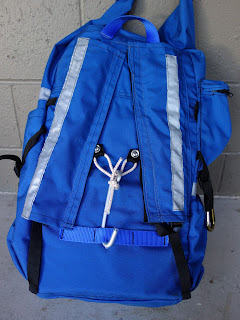My daughter Phoebe said she wanted a bag like the Arkel Bug, but in a larger size. The Bug is a 7x18x12 bike pannier that has hide-away shoulder straps for carrying off the bike. The small grab loop at the top of most pannier systems doesn't function well for carrying around campus if it holds a few textbooks, a laptop computer, lunch and a drink bottle.
Inspired by the $170 price of the Arkel Bug and my having sewn a backpack from Ray Jardine, I said, "no way is that worth $170! I can make a better one!" It was going to be so simple. Then Phoebe sent me a drawing of the bag she wanted. The Bug only has four pockets. Ours has pockets inside for laptop, pencils, pump & what-not as well as 5 pockets outside. I pretty much jerry rigged the bag's bike rack attachment hardware as I didn't see any value in purchasing the hanger hardware for $25 plus shipping from Arkel.
WATERPROOFING. I applied seam sealer to the interior seams that I could expose by turning the bag out, but total waterproofing is really the domain of the unstitched and largely pocket-less bags such as the Ortlieb tribe, otherwise the 500 denier Cordura will endure. Verson 2 is already in its creative phase with waterproofing as a special priority. Until then one must bag the contents in plastic because of the needle holes from all the seams and pockets. I said if the plastic doesn't get wet after having the pack in the rain, it's waterproof and you can leave it out. A rain cover would be easy enough to make from coated nylon and a drawstring, though they do invariably tear & develop leaks.
Volume of the main bag (12" w x 18" H x 9" Deep) is 1944 cubic inches (cubes)--30% more than the Bug. The exterior pockets add at least another 450 cubes. Metric volume is about 40 liters.
While at Olympia Supply for parts to finish out the bag, I met R.C., YetAnotherGroupOfWellAdjustedPersons, who showed interest in the bag.
Below a few more pictures:
This particular rack has an extension loop to the rear which keeps the spokes away from the bag. As such the bag did not require anything stiffer than a foam pad in the stiffener pocket. I don't recall if Planet Bike made this rack, but most other brands don't make that leap.
The bag attaches to the opposite side of the rack and therefore may attach to more racks than any other. The carabiners (not for climbers) were a ready-made device which are probably strong for the application. We found out how simple it was to shape 1/4" aluminum rod (see 2nd photo below) and will do so in the next bag.
 At left: the bag's back showing the shoulder straps with the cover flaps opened. The hook was heated and bent from 1/4" aluminum rod. The free end of both shoulder straps is tucked out of harms way in one of the tunnels on the shoulder strap.
At left: the bag's back showing the shoulder straps with the cover flaps opened. The hook was heated and bent from 1/4" aluminum rod. The free end of both shoulder straps is tucked out of harms way in one of the tunnels on the shoulder strap. Left: Without a load the bag's structure stems from the fabric (tough 500 denier Cordura). The front lower pocket is intended for Phoebe's lunch. The reflective band is sewn across a slash pocket.
Left: Without a load the bag's structure stems from the fabric (tough 500 denier Cordura). The front lower pocket is intended for Phoebe's lunch. The reflective band is sewn across a slash pocket.
Above, the main compartment with an Apple MacBook in the laptop pocket and a bear proof canister (made by Garcia, 12" H x 8.8" diameter) in the main section. You never know when a campus bear or chipmunk might want your lunch. This bag is big. Barely visible to the lower right of the bear can is the end of the pump sleeve. Version 2 may have the pump sleeve on the outside of the bag, maybe in the large side pocket. Wait for it.














